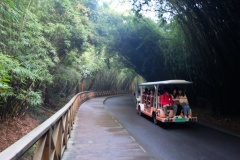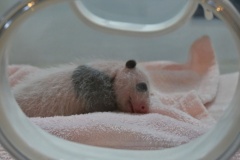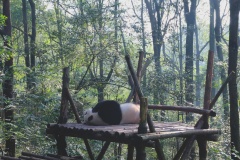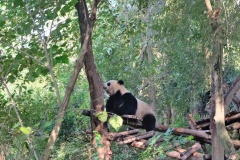Our path through China led us to Chengdu, the home of the Chengdu Research Base of Giant Panda Breeding. Naturally we took this rare opportunity to witness the Giant Panda up close. We got up very early to get to the panda base before the crowds. When we arrived at 07:15 there was already a queue and the place doesn’t open until 07:30! This is normal in China, the vast amounts of internal tourism means that any big attraction is packed with people.
We got our tickets and rushed to the panda nursery. The baby pandas are highly popular and long queues form to see them once the place fills up. We were lucky, we got there before any queue had formed and had a chance to witness this little guy.

The Chengdu Research Base of Giant Panda Breeding is a non-profit research and breeding facility for giant pandas and other rare animals. It is located in Chengdu, Sichuan, China. The Giant Panda lives in a few mountain ranges in central China, mainly in Sichuan, the region that Chengdu is located in. While estimates of the wild population of Giant Panda vary, as of 2016, there is estimated to be a total of 2,239 Giant Pandas in the world. 375 in captivity and 1864 in the wild.
The Chengdu Panda Base was founded in 1987. It started with 6 giant pandas that were rescued from the wild. By 2017 the captive panda population had grown to 176. There are other Zoos around the world that also have Giant Pandas, but not many. The Chinese government charges a considerable fee for the privilege of having a Giant Panda, $1,000,000! Also, if your zoo has a newborn Panda, the fee still applies.
After having seen the Panda nursery without having to queue, the pressure was off. We were free to roam the park without worrying we would miss anything due to overcrowding.
Red Pandas
The research facility is also home to red pandas, the giant panda’s much smaller and much redder friend. These poor guys don’t get nearly as much attention as the Giant Panda, although I doubt they mind the extra privacy.
The red panda is native to the eastern Himalayas and southwestern China. It is listed as endangered because the wild population is estimated at fewer than 10,000 and continues to decline due to habitat loss and fragmentation, poaching, and inbreeding depression. Wikipedia

Overcrowding
As I mentioned before, overcrowding is a big problem in China. If your planning a trip you need to keep this in mind. Go to any big attractions as early as possible. When we went here and to the great wall we went very early and manged to miss most of the crowds. In both cases by the time we left, the place was packed.
Take a look at this area near where some baby Pandas were. Everyone was desperate to get a view or that perfect picture. At one point the little boy to my left spotted me and lost all interest in the Panda’s, he just stared at me! Tourism from outside China is still somewhat rare in China, so expect to be stared at a lot.
In situations like this, people will push you in order to get ahead in the queue. It can be very stressful if you’re like me and get overwhelmed by large crowds.
However, even with the large crowds, the Chengdu Panda Base was a wonderful experience. Watching the Pandas play and roll around the place was highly entertaining.


















